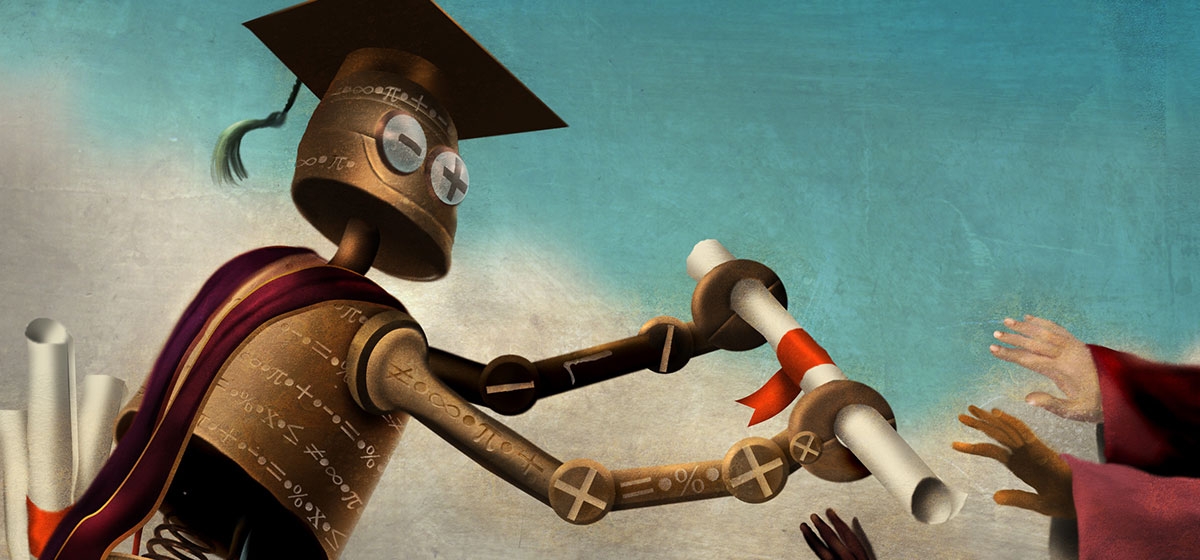
Early in Isaac Asimov’s speculative fiction classic “I, Robot,” a little girl named Gloria becomes more attached to a robot named Robbie than to her own parents. Originally wary of Robbie, Gloria’s parents grow to love and respect the tin man after it saves their little munchkin’s life by sweeping her away from the path of an oncoming tractor.
If we transport from 1950 to 2010, conventional wisdom about remote learning via the Internet is evolving in an eerily similar fashion.
In years past, if someone told you they got their degree from on online school, you’d think they weren’t wearing their academic underwear. But those views are changing as interactive learning companies are saving the academic lives of scores of young people not through robotics, but artificial intelligence (AI).
Two Pittsburgh companies in the forefront of the interactive learning arena are Carnegie Learning and Apangea Learning. For both, the key to innovation is not only technology, such as algorithms and avatars, but fundamentally changing teaching.
Both firms’ products are similar, in that they teach mathematics to students from primary school age through high school, each with interactive software used through a browser. But their approaches differ in execution.
Andy would be proud
Carnegie Learning didn’t pick its name because it sounded good for a Pittsburgh-based company. The technology, founders, and some start-up dollars all emanated from Carnegie Mellon University. The university remains a shareholder, and some of its founders continue to serve on the CMU computer science and cognitive psychology faculty.
Essentially, the Carnegie Learning software gives students problem-solving tasks and watches them work through the problems. It sees their errors and sends information to the classroom teacher about where to focus. It also provides automatic feedback to the students.
This is all accomplished through an artificial intelligence algorithm that watches over the students’ progress like the HAL-9000 from “2001, A Space Odyssey.” Of course, it doesn’t say things like, “Dave, the square root is incorrect. I’ve turned off your life support.”
Districts using the product make it central to their math curriculum. The students work three days a week in a collaborative manner with the product, which is a combination of textbooks and interactive software. The other two days a week, students work on their own with the aid of an instructor.
“What sets us apart is data,“ says Steve Ritter, Ph.D., a founder and chief scientist of Carnegie Learning. The company focuses on “how people learn and what’s working. Our product gives constant reporting on how the kids are doing.”
The distinction of in-process reporting is critical. In most settings, a teacher may not know that a student doesn’t understand the material until lousy test scores uncover a problem. By that time, the student may be so far behind, it’s almost impossible to catch up.
The Carnegie Learning product also has changed the language of how math is taught. The product helps students “understand math by connecting it to things that they see in the real world,” said Ritter. “For example, an exponential function is discussed relative to Facebook. How fast can Facebook grow based on how many users are hitting the site?”
The other key innovation is changing each student’s perception of their own math proficiency.
“Socially, students decide around middle school if they are a math person or not,” says Ritter. Carnegie Learning “relates it to exercising your brain. The outcome is getting smarter.”
Andrew Carnegie would probably be happy because the company is improving the educational lives of some 500,000 students across 2,600 school districts in states such as Florida, Georgia and Kentucky. And as a result, the 10-year-old company has grown 30 percent, year-over-year since 2005.
Andrew Carnegie’s business associate Henry Clay Frick, is also watching over Carnegie Learning in a weird sort of way. The company employs 100 people in the Frick Building, Downtown, and the original door from Henry Clay Frick’s office can be seen in the company’s lobby.
TRON comes to class
In 1982, Walt Disney released a film called “Tron,” in which actors Jeff Bridges and Bruce Boxleitner became inhabitants of a video game and did battle with the evil nemesis Sark, played by David Warner. The film was revolutionary because it incorporated live action with digital computer animation.
Apangea Learning is creating a similar revolution in the classroom, because its math students create computer alter egos of themselves, called “avatars,” as they learn math. While Apangea isn’t making math video games, it is trying to make learning math fun.
The company’s product combines online learning with live teaching by instructors working from Apangea’s offices on Liberty Avenue, Downtown. Students can work with Apangea’s faculty from early in the morning to past midnight.
Each student can access the Web-based lessons and then work through problems with a specially created computer-animated avatar. If a student gets stuck, they can speak with a math teacher using an Internet phone hook-up or through text messages.
If they really have problems picking up a concept, the teacher can send the student to the blackboard. In this case, students can access an interactive white- board, where Apangea’s teachers show students how to solve problems over the Internet rather than in a classroom.
In addition to avatars, Apangea makes learning fun through a special reward program. Students can earn points if they work through problems. They can redeem points for T-shirts or make donations to their favorite charity.
Apangea Learning’s product is based on a five-step problem-solving process, which was developed by the U.S. Air Force. The company has exclusive rights to the Air Force’s intellectual property based on its cognitive research.
The company’s biggest contract to date is providing its product and services to all of the schools in the state of Idaho.
Teach your children well
The growth of Carnegie Learning and Apangea Learning speaks to the effectiveness of their product offerings, but somehow I wonder what all this will mean to education.
Clearly, one can see educational improvement, in that both companies can spot learning problems and respond to them instantly. Maybe some kids won’t get pigeon-holed as “not a math person.”
Bear in mind that I went to school when dinosaurs ruled the earth. We weren’t making goo-goo eyes to a cell phone in hopes that a text message soon would appear.
And I remember the teachers who really had an impact on me. One was Father Leo. He scared the bejesus out of me every time I went to the blackboard, because I wasn’t much of a mathlete. After class, he would spend hours working problem after problem with me, trying to drill algebra into my brain until I finally got it. What I didn’t know then, but know now is this: Father Leo really cared and wanted me to learn algebra.
A few years ago, my classmates from St. Mark’s High School in Erie sat around at a picnic, drank beer and wondered what became of the old prince of the polynomial. We laughed until we cried.
Thirty years from now, the students of today will probably have all developed adult-onset diabetes and heart disease because they never went outside to play. But I wonder whether they’ll look back fondly and say, “Remember that old Toshiba satellite? Now there was a teacher.”




